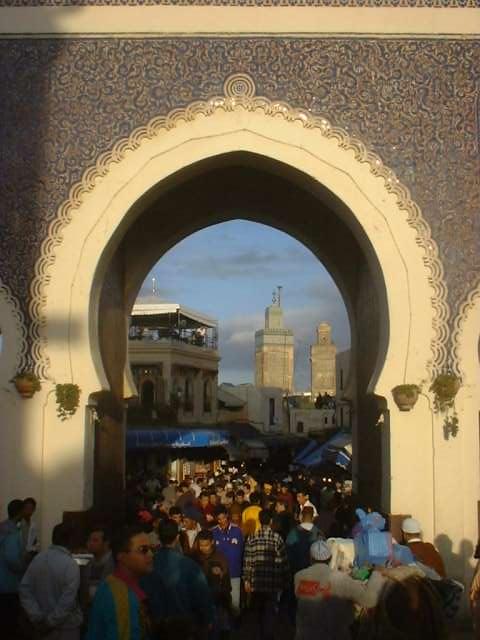 |
Bab Bou Jeloud
Fès, Morocco (28Nov00) |
I awoke with sand in my shorts and sun in my face. It was the first day of
Ramadan, the holy Muslim month of fasting, but my location high atop a
sand dune hours into the desert meant that I was far from the morning call
of the mosques of Merzouga. The start of Ramadan can only be determined
by observing the exact moment the new moon begins, so the exact start can
vary based on location.
Ramadan is one of the five pillars, or founding principles, of Islam. They
are 1) Allah is God, and Mohammed is his prophet, 2) praying five times
daily, 3) fasting during Ramadan, 4) giving alms to the poor, and 5) making
the Hajj, or pilgrimage to Mecca, if you have the means to do so. During
Ramadan, fasting begins each day at sunrise and continues until sundown,
when the fast is broken.
Seeing as I was both hungry and non-Muslim, my morning continued as usual,
with a leisurely, post-sunrise breakfast. I then hopped on my camel and,
accompanied by my guide Ali, headed back to Merzouga. I got a ride back
to Rissani in the very same bright orange taxi driven by the man with the
bright orange turban that I took out, but this time it was a communal taxi
ride and only cost a fraction of the cost.
Rissani seemed even more chaotic than when I had left it. People were
rushing around in a near frenzy, like they were preparing for the arrival
of a great storm. Then, at 5:20, a strange thing happened; everyone
disappeared. I was all alone on a street that only moments before was
exploding with activity; stores were locked tight, there wasn't a bus or
taxi in sight, and it was dead quiet. Everyone had gone home to break the
fast for the day. The situation did not bode well for those of us who
didn't have a home to go eat at. I was left eating cookies for dinner,
sitting on the curb of the street.
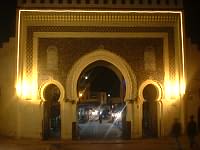 |
Bab Bou Jeloud at night
Fès, Morocco (29Nov00) |
Having spent a relaxing couple of weeks far from the big cities, I was
ready to jump back into the thick of things. I hopped on an all-night bus
headed for the imperial city of Fes. Fes is the oldest and in many ways
the most impressive of the imperial cities. Its medina, or old city, made
Marrakesh's seem small and tame. Its labyrinthine streets were packed with
butchers, craft shops, fruit stands, and, my favorite, the sweet shops.
The indisputable best of the Moroccan sweets was called chabeckai, a deep
fried ribbon of spicy pastry, drowned in a sweet syrup as thick as tar.
They were stored fused together in a giant cone almost a meter high, and
each one would require a determined yank to remove it from its sticky,
sugary hold on the pile.
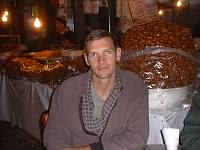 |
Guarding the chabeckai
Fes, Morocco (28Nov00) |
The medina was confusing enough that I eventually gave in and hired one of
the dozens of local kids who were pestering me to be my guide. Doing so
was a lot cheaper than hiring one of the "official" guides, but I got
exactly what I paid for. The kid ran around the medina with his friends in
tow, and I had to scramble just to keep up. Eventually, I made it to the
tannery, thet highlight of the medina. It was an extensive open-air
leather processing district, with hundreds of huge vats full of goat skins
soaking in multi-colored dyes. Spread out on the rooftops of all the
nearby buildings were skins of various colors drying in the sun, soon to
become the slippers, bags, and belts that were on sale elsewhere in the
medina.
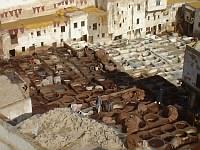 |
The tannery
Fès, Morocco (28Nov00) |
Scattered throughout the medina were the minarets of countless mosques,
each with several banks of low quality megaphones mounted on top. Just
like mobile phone cells, their locations were strategically chosen to
maximize coverage. Each prayer would usually begin with the singer
clearing their throat as loundly as possible through the megaphones. The
prayers would rain down, sputtering and crackling onto every square meter
of Fes five times every day; at sunup, midday, sundown, and twice in
between.
Eating during daylight hours continued to be problematic, and I would
resort to sneaking back to my room midday to snack in order to avoid the
obviously disapproving stares I would get when I ate in the streets. It
was becoming clear that trying to eat during the day was more trouble than
it was worth.
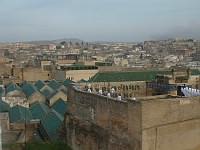 |
Fès skyline
Fès, Morocco (29Nov00) |
Through the window of my room, I could look down on a mysterious building
across the street. Huge plumes of steam would pour out of the strange,
cylindrical shaped roof, and pretty soon, my curiousity compelled me to
investigate. It turned out to be a hammam, or bathhouse, a truly unique
Moroccan institution which everyone should try at least once in their
lives.
The routine was as follows; I started by paying 30 Dirhams (about US$3) to
an old, bald, pot-bellied man who worked in the front room. After
stripping down to my underwear, he lead me through a series of three tiled,
cylindrical-roofed rooms. The first was cool, the second warmer, and the
third hot and steamy. I started in the hot room, where I was instructed
to lay on the floor. The hot tile floor heated my body to the core, as I
layed and watched an endless string of rickety old men with buckets parade
in, fill their buckets from the fountain, and leave.
After ten minutes a side, my Gandhi look-alike guide led me to the warm
room, where I once again layed on the floor. Using an abrasive mitten, he
started violently scouring my entire body like a dirty stove, peeling off
large clumps of old, dirty skin. He then soaped me down from head to foot,
while simultaneously masssaging me. Once I was thoroughly soaped up, he
grabbed one of the nearby buckets and dumped its entire contents of warm
water over me. Before I had time to catch a breath, he poured another
bucket on me, this time with very hot water. Soon he was back with two
more buckets, and he poured them both on me as well, the first cold, the
second warm.
My dousing complete, I was led back out to the front room to dry off. I
found it strange that everyone bathing in the hammam wore their underwear
during the procedure, especially since there were specific hours for men
and women thereby guaranteeing privacy. An unexpected side benefit of the
custom was that I left with a newly washed pair of underwear.
By the next day, I had decided that it was time to go native; to fast for
Ramadan. It was not only an issue of practicality, it was also one of
respect for local custom. Little did I know that doing so would open up a
whole new, wonderful side of the Moroccan people.
Fasting for Ramadan requires abstinence from anything that passes the lips -
food, water, cigarettes - from sunrise to sundown. Conveniently, or
inconveniently, depending on your perspective, there was a great ruckus at
five AM with horns and prayers to wake you up for a last meal before
sunrise. I usually would just reach out of my bed, grab a handful of
dates, and wash them down with some water before going back to sleep.
Lack of food can make anyone a bit edgy, and when a whole country hasn't
eaten, it can only spell trouble. In the final hour before sundown, when
everyone would run franticaly through the markets making last minute food
purchases, strung out and irritable from low blood sugar, fights were
inevitable.
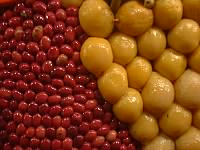 |
Olives and lemons never looked so good
Mèknes, Morocco (1Dec00) |
As I arrived in Meknes, another Imperial city, I went straight
to the market to photograph. It was a visual delight, with the line
between food and art completely blurred; olives and lemons would be
stacked together in intricate patterns like Lego blocks, every sweet would
be placed in the exact right spot. It seemed a shame to buy anything and
spoil the display. As I was snapping away, a great commotion was happening
in one end of the market. A man, yielding a knife, was engaged in a
yelling match with another. People gathered around to watch the action,
but no one seemed to see it as much more than just entertainment. Sure
enough, the testosterone level soon ebbed, and everyone got back on with
their business.
I broke my fast by snacking on a few things I had bought in the market - I
obviously had no regrets about destroying public art - but as I left my
hotel, I met a man who invited me to break the fast with him and his
family. Fearful that it was just another Moroccan scam to liberate me from
my money, I told him thanks, but I had already eaten. Still, he insisted I
join him for tea at the least, and I figured that it couldn't be too much
trouble, so I accepted. Also joining us was my friend Tamsin, a British
woman whom I had run into so many times by random in Morocco that it felt
like one of us was following the other.
When tea time arrived, we went to the house and knocked. We were greeted
by Ahmed, a slender, well dressed man in his mid 30's. As he shook each of
our hands in turn, he would move his hand to his heart and briefly touch
it, as if he were taking a piece of each of us into his own heart. It was
the standard greeting in Morocco, and it hinted at the deep, heartfelt
connection in Moroccans that sometimes got lost amongst the hustlers and
scamsters of the cities. The house was beautiful; all the walls were
covered in ornate blue tiles, making it look like some kind of luxurious
bathhouse. Along the walls ran a sofa made of many square cushions, and on
the wall, a guilded Quran (Koran.)
The women of the house, his wife and mother, were kept in a separate room,
as they were not allowed to entertain guests, only prepare the tea. After
tea, Ahmed proceeded to bring out an endless number of photos, which he
had neatly packed in a box. Apparently it was some wedding that his mother
had attended, or perhaps several weddings. It was rather hard to tell, and
his English was far from comprehensible. Tamsin and I, not wanting to be
rude and bolt immediately after tea, sat patiently through a half hour of
photos and mangled monologue, but eventually we tired of mechanically
bobbing hour heads in feigned understanding, and we politely make our exit.
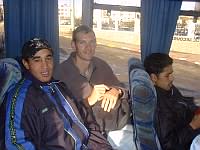 |
Me and Rachid
Mèknes, Morocco (3Dec00) |
The hospitality never stopped. Each time I met someone in the street and
casually mentioned that I was fasting, they would invariably invite me to
their home for dinner; it seemed that joining them in the fast earned
tremendous respect. Once such person I met was Rachid, a slow but sweet
man who had once lived in Canada, until a series of run-ins with the law
resulted in his being deported back to Morocco. He was patiently waiting
until he would be allowed to return. Rachid insisted that I join him at
his family's house to break the fast. Once again, the women were noticible
in their absence, and only Rachid and I ate together.
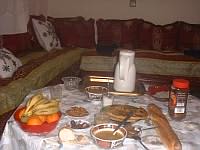 |
Breaking the fast
Mèknes, Morocco (2Dec00) |
There seemed to be a near ritual with how they ate the meal. All the food
would be layed out, and they would patiently sit and wait until you could
hear the prayers bellowing out, just as the sun set. First, they would eat
a single date. Then, a bowl of hearty lentil soup called Harina. Next
came the bread, olives, chabeckai, and tea, and soon after, smoking. Some
people would postpone the food and go straight for a cigarette, and the
smoke of choice was hashish. The smoking seemed to continue for the rest
of the evening. You could see it wafting from every single
bar and cafe in town, from the instant of sundown until the wee hours of
the morning. The Moroccan's obsession with hashish was impressive -
apparently the absence of alcohol necessitated a strong stubstitute.
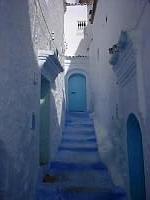 |
Bluewashed streets
Chefchaouen, Morocco (4Dec00) |
As I slowly worked my way back up north to the town of Chefchaouen,
the invitations for dinner just kept coming. Even on the night
when I ate in a restaurant to break the fast, I was immediately invited to
a table, and we all shared the various offerings as one family. They
refused to let me pay. Fasting became an amazing way to connect with the
people, to no longer be an outsider.
Chefchaouen was a beautiful little town, built up into the sides of a steep
hillside. Everything in town was painted in pale bluewash, giving it a
very Mediteranean feel. Chefchaouen was also a hippie hangout - the
Kathmandu of Morocco. Pleasant and quiet, it was full of westerners
seeking the eternal chill-out. From the moment I arrived, I was whisked
away by a British man into a small cafe, where I found myself in the middle
of a drumming circle.
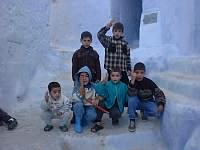 |
More kids
Chefchaouen, Morocco (4Dec00) |
Chefchaouen was, even for Morocco, awash in marijuana and hashish. The
only annoying part of Chefchaouen were the people tring to sell hashish, as
well as Berber carpets. "Hello, where are you from? California? Many
people from California come to my shop to buy authentic Berber carpets."
As I was wandering my way around town photographing, I had one man try in
vain to convince me to buy some hash and smuggle it home in tiny balloons
in my stomach. I assured him that it would be much, much longer than a
digestive cycle before I found my way back to my own country.
After taking all the chill-out I could handle, I, Tamsin, who I not
surprisingly ran into yet again, and a couple of other friends met along
the way all started to make our way across the Straight of Gibraltar and
into the western world once again.
Morocco would be missed.

